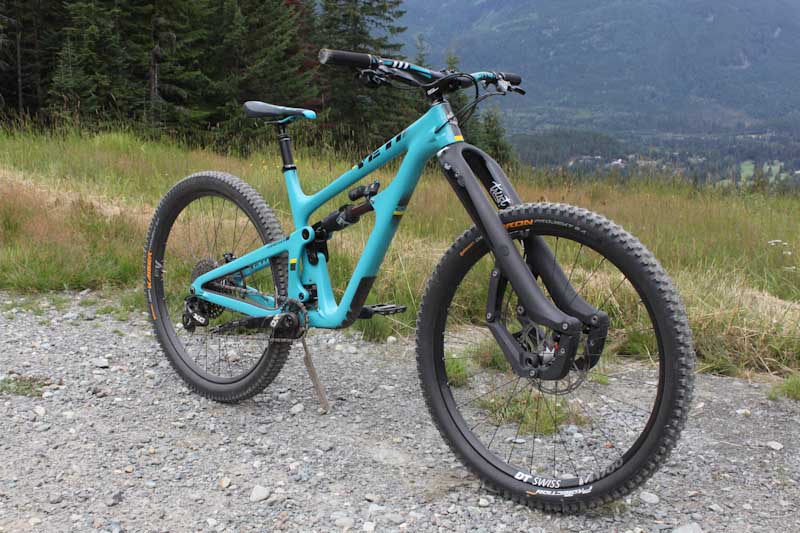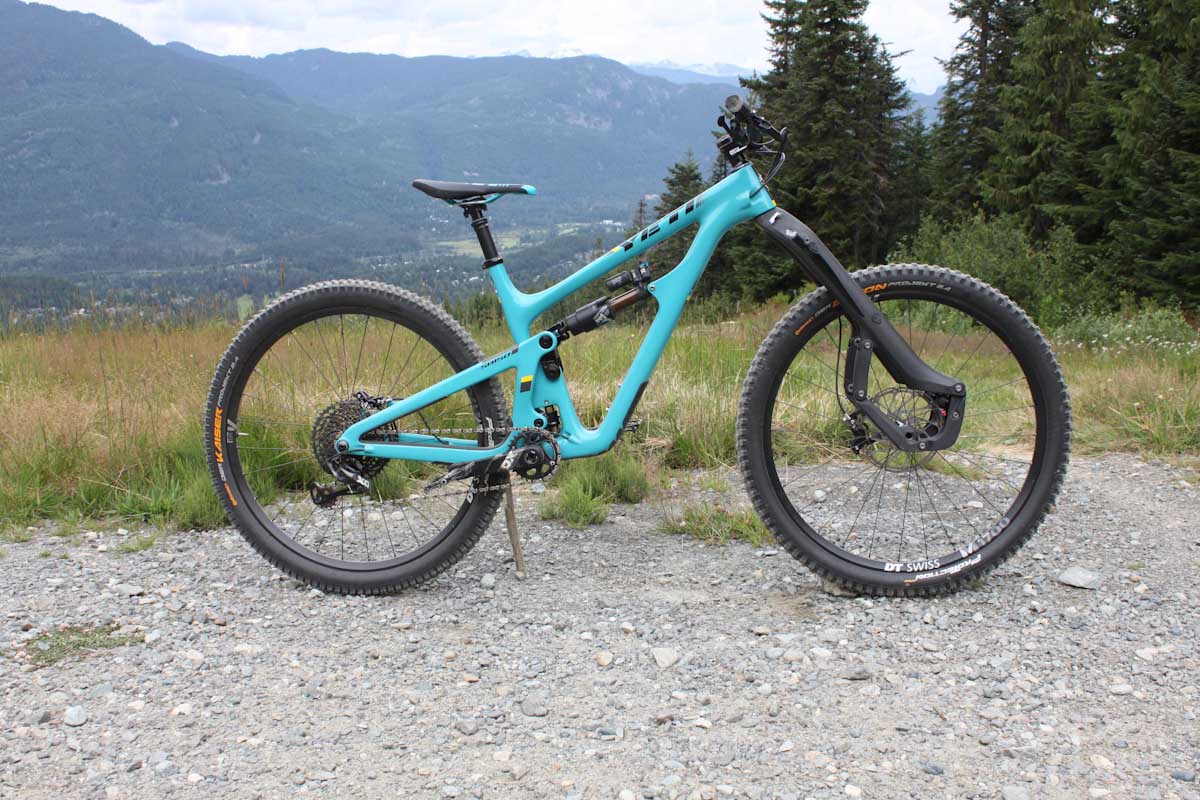If you didn’t get the Message, maybe you’ll hear the Shout! Following up on the Message, their first trailing multi-link fork, Trust Performance has created a longer travel version aimed at enduro riders called the Shout. During Crankworx Whistler Trust snuck out a new Shout fork for media demos, and I got the chance to take it for a brief ride.
The Shout looks a lot like Trust’s existing Message model, which is good because it was still under embargo during Crankworx. Thankfully no-one guessed it was a new product while I was parading it around the Whistler Bike Park. In this article we’ll cover my initial impressions of how the Shout rides, but be sure to check out my other article covering the key details and specs on the fork.
Before I even get into how the fork rode, I need to address how it looks – the appearance of this fork is something you can’t avoid taking into consideration. During my few laps in the bike park, I caught a ton of people eyeballing my test bike. The best comment I got about the fork was “It looks like an alien holding your front wheel on!” The Shout could have been called ‘the conversation’ because with this thing on your bike, you’re definitely going to find yourself answering questions from curious riders!
Set up:
 The Shout fork is marginally more complicated than a regular fork to set up. Once you’ve checked Trust’s chart to see how much air pressure matches your body weight, you’ll pump the same pressure into both fork legs. One key thing to note here – You’ll need a shock pump with an extended head to access the air valves that sit inside the Shout’s legs.
The Shout fork is marginally more complicated than a regular fork to set up. Once you’ve checked Trust’s chart to see how much air pressure matches your body weight, you’ll pump the same pressure into both fork legs. One key thing to note here – You’ll need a shock pump with an extended head to access the air valves that sit inside the Shout’s legs.
Adjusting rebound is the same as usual, with the knob located inside the linkage on the drive-side fork leg. In lieu of a traditional O-ring, the Shout has a travel indicator on the non-drive side. This little red tab floats on a pivot and points to the travel percentages printed on the link, so you can check how much sag and compression you’re getting.
The only other complicating factor to the Shout is that allen keys are required for fine-tuning the compression. The Shout’s Open and Medium modes’ low-speed compression can be tuned separately, by twisting the bolts found inside the drive-side fork leg. Switching between Open, Medium and Firm modes is easy; you just flip the lever on the top of the fork leg.
Compression can be further tuned by adding or removing air volume spacers (they call them ‘Huck Pucks’). Conveniently for my test, the fork seemed OK as it was and we didn’t need to play with the pucks. If you do need to make adjustments, it requires two allen keys to detach the lower links and remove the air springs from each leg.
Ride Impressions:
 Now, onto the important part – how it rides. The Shout definitely offers excellent small-bump compliance. It has a very sensitive initial stroke that makes gliding over less technical sections of trail feel almost like riding on pavement. This ensures great traction from your front wheel, as the tire remains well planted on any smooth to moderately bumpy terrain.
Now, onto the important part – how it rides. The Shout definitely offers excellent small-bump compliance. It has a very sensitive initial stroke that makes gliding over less technical sections of trail feel almost like riding on pavement. This ensures great traction from your front wheel, as the tire remains well planted on any smooth to moderately bumpy terrain.
When I got onto a much chunkier, more technical trail, I didn’t feel like there was a vast difference between the Shout and a traditional telescoping fork in terms of bump absorption. I then went over to a jump line that had plenty of brake bumps, and again I can’t say the Shout handled the harsh chatter noticeably better than a traditional fork. It did a fine job of absorbing impacts, but it wasn’t the game-changing experience people might hope for when looking at this unorthodox fork.
With limited ride time I didn’t play with fine-tuning the Open and Medium modes, but I did try both settings. The Firm setting on the fork is very firm, so it wouldn’t make sense to ride the bike park in that mode. I’d reserve that setting for paved surfaces or very smooth fire road climbs. My first lap was in Open mode, and I got about 80% travel on runs that were technical but didn’t have any big hits. After moving to a rougher run and a jump line, I squeezed every millimeter out of the Shout.
The fork ramped up enough to require a hard hit to achieve full travel, but it wasn’t so stiff that I (a lightweight) couldn’t compress it fully. In Open mode, the fork remained supple until that final ramp-up kicked in. Remember, the Shout’s ramp-up is adjustable via volume spacers, but I got lucky and the demo fork was set up appropriately for me.
At Trust’s suggestion, I tried the fork’s Medium mode on a jump line for lap two. As I was told, this mode keeps the fork riding higher in its travel. The Shout still did a great job of absorbing small and medium-sized bumps, but when bigger hits or brake bumps came along it was obvious that the fork was in a stiffer setting. The Medium setting firms up the top third of the fork’s travel considerably, so it’s OK for smoother trails but on rough terrain you’ll want to be riding wide open.
Before riding the Shout, I was mentally preparing myself for the bike to feel quite different than normal, but it really didn’t require much adjustment at all. With a linkage fork, the bike’s head tube angle doesn’t change as much as a traditional fork as you sink into your travel. I thought I’d be in for a whole new ride experience due to this effect, but in reality it doesn’t feel as different as you might expect. Diving into corners or thrashing through rough terrain didn’t require any change to my body position, and the bike’s steering didn’t seem to change much either. On one hand, this is good because the fork doesn’t require you to re-learn how to ride your bike. On the other hand, some riders might be disappointed that it doesn’t offer a radically different feel.
One thing that did feel different was not seeing the fork move while you pound down the trail! In comparison to a traditional fork jackhammering constantly as you ride, the Shout’s fork legs barely move, and it’s a bit odd to the eye. The linkages are doing all the work below, but you can’t see them from a riding position. This proved easy to get used to, but it was an interesting side effect I figure is worth mentioning.
My short ride convinced me that Trust’s trailing multi-link design offers great small and medium bump absorption, and keeps your wheel tracking solidly through such terrain. When the bumps got bigger, I felt the difference between the Shout and a telescoping fork’s ability to suck up hits was marginal. I also expected it to feel much more different on the bike than it did, but that could be seen as a positive or a negative. Trust Performance has inquired about sending me a Shout for a longer term, so hopefully I’ll have a more thorough review for you this fall.









